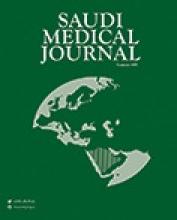Abstract
OBJECTIVE: To evaluate the reference intervals for fasting total plasma homocysteine concentrations in Saudi healthy males and females in relation to age, sex and the nutritional status of folate and vitamin B12.
METHODS: A prospective study was conducted on randomly selected Saudi healthy males (n=642) and females (n=784) living in the Jeddah area, Kingdom of Saudi Arabia. Plasma homocysteine together with serum folate and plasma vitamin B12 concentrations were determined. Analysis of variance was used to examine differences among various groups according to age, sex or folate, or both or vitamin B12 status for different variables. Correlations were carried out using multiple linear regression analysis.
RESULTS: Reference intervals for plasma homocysteine concentrations in Saudi healthy males and females (age 20 -69 years) was documented. The age-adjusted geometric mean of plasma homocysteine concentration was significantly greater in males (9.91 umol/L) than in females (8.08 umol/L) (P<0.0001). In both males and females, values for serum folate and plasma vitamin B12 concentrations significantly and negatively correlated with plasma homocysteine concentrations (P<0.000). Serum total cholesterol showed significant positive correlations with plasma homocysteine in both males (r=0.448, P<0.000) and females (r=0.313; P < 0.000). Diastolic (r= 0.182; P<0.001) and systolic (r=0.309; P < 0.000) blood pressure values showed significant positive correlations with plasma homocysteine concentrations in females only. Stepwise multiple linear regression analysis showed that in both males and females, age, sex, serum folate, and waist-to-hip ratio and plasma vitamin B12 were significant determinants of plasma homocysteine concentrations.
CONCLUSION: The first data on plasma homocysteine concentrations in Saudi healthy males and females are reported. Age and sex differences were confirmed and a significant inverse relationship between plasma homocysteine concentrations and that of serum folate and plasma vitamin B12 was observed. Various independent variables including age, sex, serum folate, waist-to-hip ratio and plasma vitamin B12 contributed to the changes in plasma homocysteine. Plasma homocysteine concentrations should be evaluated in patients at risk for cardiovascular and other related diseases in the Saudi population.
- Copyright: © Saudi Medical Journal
This is an open-access article distributed under the terms of the Creative Commons Attribution-Noncommercial-Share Alike 3.0 Unported, which permits unrestricted use, distribution, and reproduction in any medium, provided the original work is properly cited.






